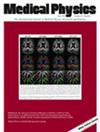Imaging lung tumor motion using integrated-mode proton radiography—A phantom study towards tumor tracking in proton radiotherapy
Abstract
Background
Motion of lung tumors during radiotherapy leads to decreased accuracy of the delivered dose distribution. This is especially true for proton radiotherapy due to the finite range of the proton beam. Methods for mitigating motion rely on knowing the position of the tumor during treatment.
Purpose
Proton radiography uses the treatment beam, at an energy high enough to traverse the patient, to produce a radiograph. This work shows the first results of using an integrated-mode proton radiography system to track the position of moving objects in an experimental phantom study; demonstrating the potential of using this method for measuring tumor motion.
Methods
Proton radiographs of an anthropomorphic lung phantom, with a motor-driven tumor insert, were acquired approximately every 1 s, using tumor inserts of 10, 20, and 30 mm undergoing a known periodic motion. The proton radiography system used a monolithic scintillator block and digital cameras to capture the residual range of each pencil beam passing through the phantom. These ranges were then used to produce a water equivalent thickness map of the phantom. The centroid of the tumor insert in the radiographs was used to determine its position. This measured position was then compared to the known motion of the phantom to determine the accuracy.
Results
Submillimeter accuracy on the measurement of the tumor insert was achieved when using a 30 mm tumor insert with a period of 24 s and was found to be improved for decreasing motion amplitudes with a mean absolute error (MAE) of 1.0, 0.9, and 0.7 mm for 20, 15, and 10 mm respectively. Using smaller tumor inserts reduced the accuracy with a MAE of 1.8 and 1.9 mm for a 20 and 10 mm insert respectively undergoing a periodic motion with an amplitude of 20 mm and a period of 24 s. Using a shorter period resulted in significant motion artifacts reducing the accuracy to a MAE of 2.2 mm for a 12 s period and 3.1 mm for a 6 s period for the 30 mm insert with an amplitude of 20 mm.
Conclusions
This work demonstrates that the position of a lung tumor insert in a realistic anthropomorphic phantom can be measured with high accuracy using proton radiographs. Results show that the accuracy of the position measurement is the highest for slower tumor motions due to a reduction in motion artifacts. This indicates that the primary obstacle to accurate measurement is the speed of the radiograph acquisition. Although the slower tumor motions used in this study are not clinically realistic, this work demonstrates the potential for using proton radiography for measuring tumor motion with an increased scanning speed that results in a decreased acquisition time.


 求助内容:
求助内容: 应助结果提醒方式:
应助结果提醒方式:


